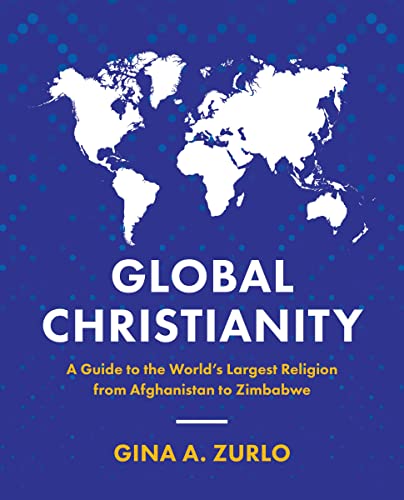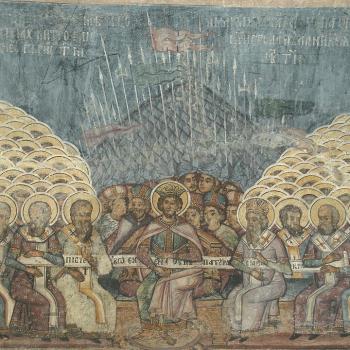I’m pleased to welcome Gina Zurlo, the co-founder of the Center for the Study of Global Christianity at Gordon-Conwell Theological Seminary, to the Anxious Bench. Her most important book to date, written with Todd Johnson, is the third edition of the World Christian Encyclopedia (Edinburgh University Press, 2019). Her most recent book Global Christianity: A Guide to the World’s Largest Religion from Afghanistan to Zimbabwe, a popular reference book based on the WCE, is just out with Zondervan and is the focus of our conversation below. The book devotes a page or two for each country of the world. Each entry includes several paragraphs of narrative, interesting facts, numbers of churches and missionaries, a graph that contrasts the percentage of Christians between 1900 and 2020, and much more. I know this outs me as a hopeless nerd, but I read one entry daily that matches Worldle’s nation of the day. —David R. Swartz
***
David: Blow our minds. Give us a statistic having to do with world Christianity that will shock us.
Gina: One of our most-cited statistics at the Center for the Study of Global Christianity is this: 87% of all Muslims, Hindus, and Buddhists do not personally know a Christian.
From one perspective, this is odd, because Christianity is the world’s largest religion with 2.5 billion adherents. How can it be that so many members of other religions have so little personal contact with Christians? The answer is, in short, the social scientific concept of “homophily,” or, “birds of a feather flock together.” For the most part, people are comfortable living, working alongside, and marrying people who think like them, and this very much also applies to religion. In most places in the world, Christians simply have little personal contact with people of other faiths.
 David: Of the six continents where humans live in any numbers, which has experienced the most dramatic religious transformation in the last century or so?
David: Of the six continents where humans live in any numbers, which has experienced the most dramatic religious transformation in the last century or so?
Gina: Africa has experienced the most dramatic religious transformation of any continent over the last 120 years. In 1900, Africa was largely traditional religionist in the south and Muslim in the north, with 9.6 million Christians and 35 million Muslims. Christianity grew to more than 667 million (49%) by 2020, while Muslims grew to 562 million (42%). Ethnic religionists (practitioners of African Traditional Religion) dropped from 58% in 1900 to 8% by 2020. By 2050 it is expected that Christians and Muslims together will represent 93% of Africa’s population, and this has tremendous implications for how Christians get along with their Muslim neighbors, friends, and family members.
David: You write, “Christianity is no longer a Western-majority faith.” What are some numbers that prove this thesis?
Gina: Christianity’s shift from the global North to the global South is becoming more pronounced. In 1900, 82% of all Christians lived in Europe and North America, and by 2020 this had dropped to just 33%. This means that, today, 67% of Christians live in Africa, Asia, Latin America, and Oceania. We anticipate this trend to continue and estimate that 77% of all Christians will live in the global South in 2050.
David: How do you define “Global North” and “Global South”?
Gina: We use United Nations designations for our country populations and borders. According to the UN, the Global North consists of Europe and North America, and the Global South includes Asia, Africa, Latin America, and Oceania.
David: I’d like to know more about the methods you used. How did you get all this data?
Gina: We gather data from everywhere we can possibly think of, but mostly three categories: governmental censuses, social scientific surveys and polls, and from religious communities themselves. Utilizing censuses and surveys are standard practice in the demography of religion, but we go a step further in asking religious communities themselves trends related to adherence. We believe this more grassroots approach gives a more realistic and accurate picture of what’s happening in religious communities on-the-ground.
David: What makes data collection and analysis of world Christianity difficult? And what do you do to mitigate these problems?

Gina: It might seem ironic, but this kind of data gathering in World Christianity is in some ways more difficult now than when my predecessor, David B. Barrett, first did it in the 1960s. Denominational boundaries are far fuzzier now than they were in the 20th century. Christianity is generally declining in the historic/mainline/mission-founded denominations and growing rapidly in area that are more difficult to quantify, such as the Pentecostal/charismatic movement, underground house churches, networked movements, and background believer movements. This is why using on-the-ground methods are critical, because these movements often get looked over by “official” census data.
David: How does being in a restricted country shape the growth curve of Christianity? Are there patterns, or are the cases idiosyncratic?
Gina: There are many differences of opinion on the relationship between religious restrictions and religious change. Some believe that religious restrictions can cause foment that attracts people to look elsewhere for fulfillment and community, hence providing opportunities for people to convert to Christianity. Others believe that religious restrictions make it extremely difficult for people of other faiths to access the Christian message and learn about it thoroughly to make an informed decision about conversion. In places where Christianity is growing in restricted areas, some observable patterns may have emerged. It grows among people who have felt overlooked by a ruling power, such as indigenous communities in Latin America who embraced the Protestant Pentecostal message having felt outcast by dictatorships supported by the Catholic Church. This also applies to gender, since we have seen numerous movements in restricted access countries led entirely by women, and in many causes, young women. This was the case in the Chinese house church movement in the late 20th century, where an estimated 80% of leaders were women. We also see that in these places, Christianity grows as much as possible off the grid, even to the extent where people publicly identify with their family religion (Islam, Buddhism, Hinduism) but privately identify as Christians (Muslim background believers, etc.).
David: Your dissertation explored the life and work of David Barrett, someone you have called a “missionary statistician.” In what ways was Barrett part of the intellectual and methodological genealogy of this book?
Gina: Nearly everything we do at the Center for the Study of Global Christianity traces its roots to the work of David Barrett in Kenya, beginning in the late 1950s. He was the first person to quantify the entire religious and non-religious worlds, and put all the world’s Christians together in a single book, with no theological nor exclusionary boundaries between them. This was a remarkable achievement! TIME Magazine reporter Dick Ostling called the first edition of the World Christian Encyclopedia a “miracle from Nairobi.” We have departed from Barrett’s method in some ways, such as reorganizing our taxonomy to match global trends, and adding a gender variable to the World Christian Database. But at the core, we’re continuing Barrett’s legacy into the future.
David: What are a couple of the most salient gendered changes in world Christianity over the last century?
Gina: Historians and social scientists have stated for decades that Christianity has always been majority female. Dana L. Robert called World Christianity a “woman’s movement” in 2006 because of the gendered reasons for conversion (i.e., women and men have specific reasons for becoming Christians, and women tend to do it more often!). Ask any mission organization executive if there are more men or women serving as overseas missionaries and I guarantee you they will say women – though, look at their leadership boards, and you’ll see mostly men. There is a chronic lack of data regarding gender in World Christianity. Denominations, church networks, and organizations all over the world collect all kinds of data, but they either do not collect information on gender or they choose not to report it. Nevertheless, evidence is showing that women are the most faithful of their communities and most surmise that these churches and organizations would collapse without them.
David: What is the least Christian nation on earth?
Gina: By percentage, Afghanistan is the least Christian nation in the world, with just 0.02% of its population Christian (around 7,500 Christians in a country of 39 million).
David: What is the most Christian nation on earth?
Gina: This one is a little misleading – the Holy See is technically the “most Christian” country in the world, at 100% Christian (809 people!). After that, Samoa is the country with the highest share of Christians, at 99% (of a population of 196,000 people).













